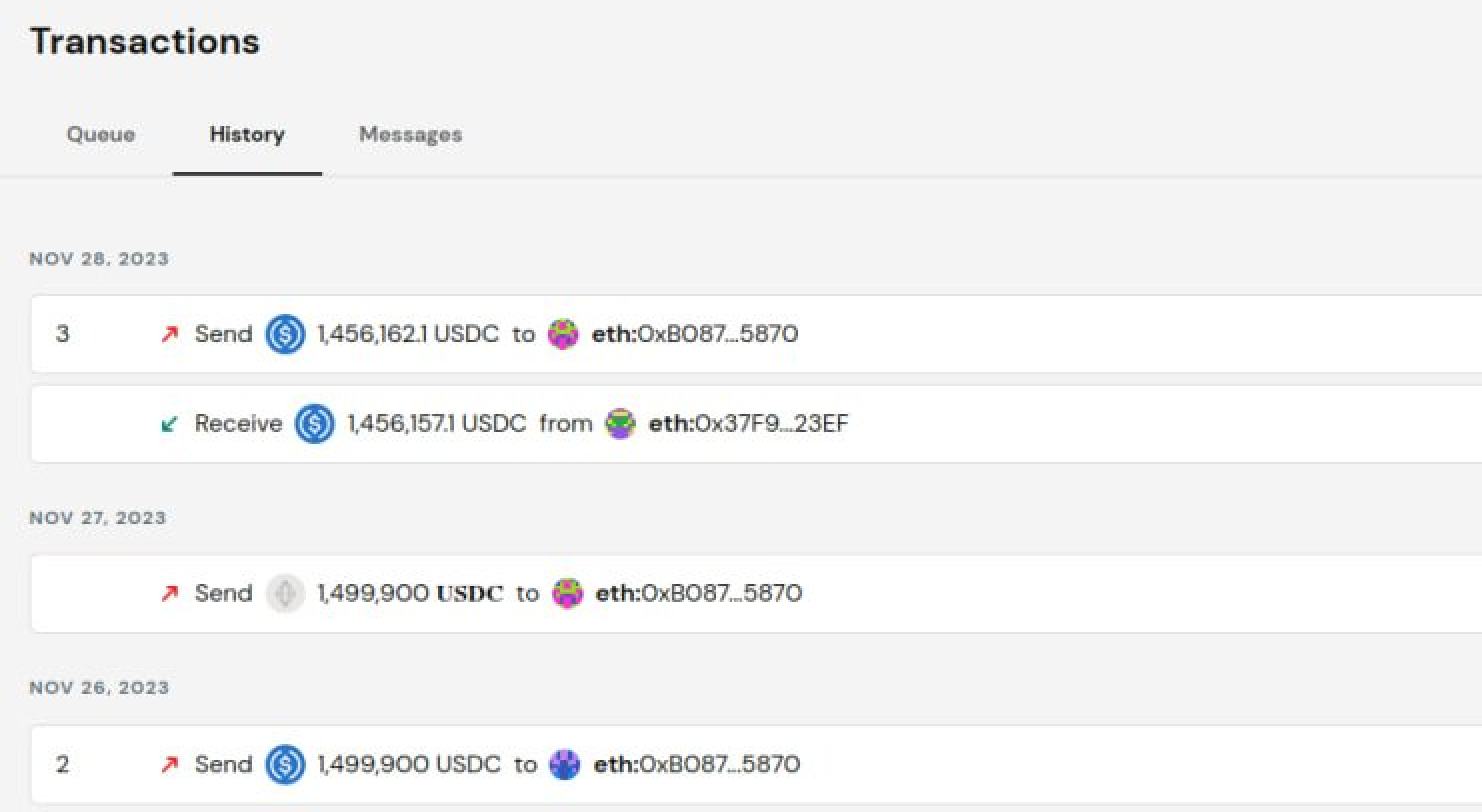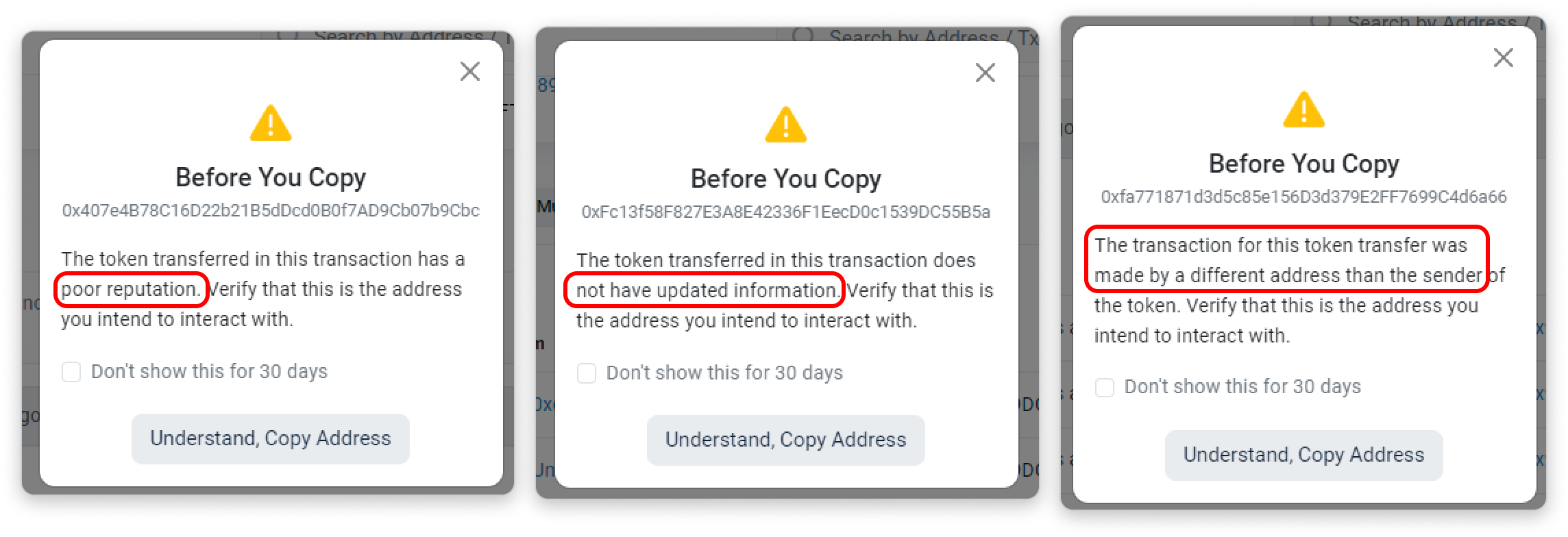Table of Contents:
- What is Address Poisoning
- How address poisoning works
- What you can do to protect yourself
- Conclusion
- Further reading
What is Address Poisoning
Address poisoning involves the attacker creating deceptive transactions in the victim's address transaction history, tricking victims into sending funds to the attacker's address.
The tactics employed by address poisoning attackers have evolved over time, yet their objective remains the same: deceiving users into copying the attacker's address when sending onchain transactions.
In this article, we will go through:
How Does Address Poisoning Work?
To increase the likelihood of users copying the wrong transfer address, attackers deploy a combination of spoofing methods in their address poisoning schemes:
Token spoofing
Attackers deploy token contracts with the name and symbol resembling those of well-known or familiar tokens. The aim is to trick victims into believing these tokens are legitimate.

Block explorers are not the only interfaces attackers use to deceive unsuspecting users.
When other dApp frontend interfaces aggregate all transactions in one tab, anyone can create a fake "ETH" token and disguise it as a genuine ETH transaction:

The solution? Inspect the transaction and compare it with several other sources to ensure its legitimacy.
Address spoofing
Attackers use a 'vanity' address generator to create an address that closely resembles a target address's first and last few characters. When truncated in the middle, it appears exactly the same as the target address, thereby fooling unsuspecting victims.
Attackers can then use the spoofed address to send tiny amounts of legitimate tokens like USDC or USDT to the victim's address, hoping that the victim will copy the spoofed address and unknowingly send their funds to the attacker the next transaction. Read more here.
Below is an example of a victim who mistakenly transferred $20m to the spoofed address. Please note the striking similarity in the first and last few characters:
wowwwwwwwww 10hrs ago someone sent $20m to one of the address poisoning / 0-value transfer spams 😱😱😱😱😱😱😱😱😱😱
— Tay 💖 (@tayvano_) August 1, 2023
bad addy
0xa7bf48749d2e4aa29e3209879956b9baa9e90570
real addy
0xa7b4bac8f0f9692e56750aefb5f6cb5516e90570https://t.co/PyZW2DEnha pic.twitter.com/gnImqKJomx
Event spoofing
Attackers take advantage on the implementation of the ERC-20 token standard. The transferfrom() function enables another address to transfer tokens on behalf of the function caller and subsequently emit the Transfer event.

These spoofed Transfer events can either mislead users into thinking:
- A popular figure is transferring a particular token, or
- An entity is airdropping tokens to users.


Attackers take advantage on the design of ERC-20 token standard to carry out address poisoning attacks in 2 ways:
-
Zero-value token transfers (Spoofed event + address)
For transfers involving legitimate tokens like USDC/USDT/DAI, attackers would initiate a transferFrom function sending 0 value tokens. Every address is default to 0 value approval, so the Transfer event is emitted.
They then combine this with address spoofing to increase the likelihood of a victim copying the wrong transfer address and sending money to the attacker.
Notice how the spoofed address looks almost exactly the same as the target address:

-
Spoofed token-transfers (Spoofed event + address + token)
The goal is to mimic the target token transfer event as closely as possible, so the victim would mistakenly copy the spoofed address and send money to the attackers.
Attackers deploy spoofed token to USDC/USDT/DAI, initiates a transferFrom function from or to the spoofed address, with token value matching the target transfer event's.
Notice how you wouldn't be able to tell these 2 events apart if Etherscan displays the spoofed USDC the same way as the legit one:

Attackers constantly monitor the chain for frequent or huge token transfers (usually stablecoins) and immediately create spoofed events to pollute an address' token transfer history.
Notice how the spoofed events are created as soon as 1 minute after the target token transfer:

Address poisoning takes place on many different Web3 interfaces, not limited to Etherscan. See how a spoofed token transfer event displayed from a wallet interface can cause the victim to copy the wrong receiver address, costing them ~$1.45M:

Attackers routinely employ contract functions with unique method IDs to carry out bulk event spoofing. These functions are difficult to trace, given that the associated contracts remain unverified.


What you can do to protect yourself
To combat Token Spoofing:
- Note that any ERC-20 token that hasn't been verified by Etherscan may not have its logo displayed correctly, please be cautious when interacting with them
- Compare a token with various sources, and if you find them suspicious, do not interact with these tokens. Hide them with Token Ignore List
To combat Address Spoofing:
- Use a wallet's contact list or whitelist address feature
- Naming your address with human-readable domain names (Note: domain names may also be spoofed, read more here)
- Take note of the address highlight feature, it helps you tell apart similar looking addresses:

- Etherscan recently displayed more of the first and last few characters of an address to make spoofed address distinguishable (each additional character is increasingly difficult for attackers to generate):

To combat Event Spoofing:
- Turn on the option to hide zero-value token transfers
- Take note of the popup reminder that appears when copying address on token transfer pages if:
- Tokens are of poor reputation
- Tokens do not have updated information
- Transaction originated from an address that is different to the sender of the token

- Transfers of tokens with poor reputation are now hidden across Etherscan by default
- Transfers of tokens added to the Custom Ignore List are also hidden throughout the site
🆕 Updates on Token Transfers
— Etherscan (@etherscan) January 29, 2024
1. Transfers of tokens with poor reputation are now hidden across Etherscan by default
2. Transfers of tokens added to the Custom Ignore List are also hidden throughout the site pic.twitter.com/qQFVM5CNT5
Team Etherscan aggressively flags spoofed tokens and addresses, be cautious when interacting with them.
Conclusion
Address poisoning attacks are a recurring problem simply because one huge amount wrongly sent by a victim is enough to recover the attackers' operation costs. It requires a concerted effort from parties across the Ethereum stack to put safeguards/standards in place to protect users and drive down the profitability of these attacks.
These attacks are possible because attackers have found a way to circumvent token standards and use block explorers and wallet interfaces to deceive users. Learn more about some common issues related to non-standard ERC-20 tokens on Etherscan: https://info.etherscan.com/non-standard-token-contracts/
Further reading on Address Poisoning Attacks
- https://blog.mycrypto.com/bad-actors-abusing-etherscan-to-trick-you
- https://medium.com/etherscan-blog/spoof-tokens-on-ethereum-c2ad882d9cf6
- https://www.coinbase.com/blog/zero-transfer-phishing-part-1-attack-analysis
- https://www.coinbase.com/blog/zero-transfer-phishing-investigation-part-2-phishing-campaigns
- https://www.coinbase.com/blog/zero-transfer-phishing-investigation-part-3-hashlinked